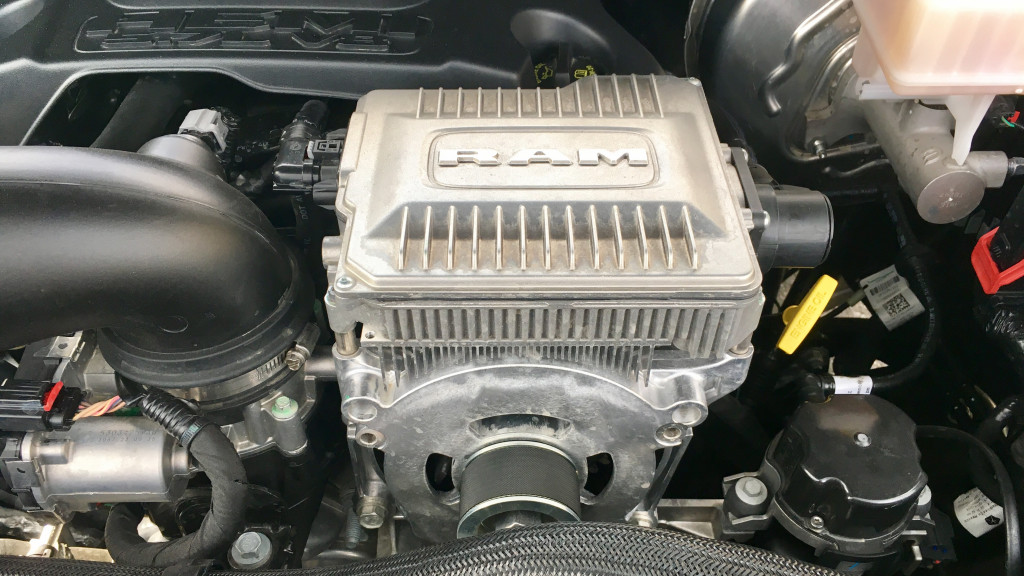In 2019, Fiat Chrysler sold a higher percentage of hybrid vehicles—of its total U.S. sales—than Toyota.
And yet for the eighth straight year, FCA is anticipated to post the lowest U.S. fleet fuel economy among vehicle makers.
That comes from the 2019 EPA Automotive Trends Report, released earlier this month by the U.S. EPA with preliminary figures for 2019.
FCA put hybrids in 16% of its vehicles for model year 2019. Toyota, often thought of as the hybrid leader and the maker of the current top-selling hybrid, the RAV4 Hybrid, put hybrid systems in 9% of its vehicles (including Lexus). But there’s a big asterisk: That figure includes mild hybrids—most notably, the eTorque system used in the Ram 1500 and Jeep Wrangler.

eTorque system in 2019 Ram 1500
It’s a lesson that a showroom filled with “hybrid” badges doesn’t necessarily mean that a brand is being especially green; and it points to how the mix of vehicles can be quite different between carmakers.
FCA, for example, is extremely dependent on trucks and SUVs; and to its credit, its full-size Ram 1500 with eTorque gets far better mileage than any current Toyota full-size truck.
As Green Car Reports has previously noted, the 48-volt eTorque system might not meet the definition of a hybrid system to many readers and hybrid shoppers, but it does boost fuel economy by about 2 mpg, for trucks with EPA combined mpg figures in the low 20s. That’s a mileage boost of nearly 10 percent.
FCA’s figures are expected to improve, from 21.7 mpg in 2018 to 22.3 mpg in 2019. Those are based on what the EPA calls “real-world fuel economy”—using the full range of EPA driving cycles “to capture a wider range of operating conditions (including hot/cold weather and higher acceleration) that an average driver will encounter.”
![Fuel economy and emissions progress by manufacturer, 2013-2018 [U.S. EPA] Fuel economy and emissions progress by manufacturer, 2013-2018 [U.S. EPA]](https://images.hgmsites.net/lrg/fuel-economy-and-emissions-progress-by-manufacturer-2013-2018-u-s-epa_100740481_l.jpg)
Fuel economy and emissions progress by manufacturer, 2013-2018 [U.S. EPA]
Using that, so-called “car SUVs” had the largest improvement in 2018—going from 26.1 mpg to 27.3 mpg—while “truck SUVs” were the second most-improved.
The EPA reported that the average hybrid-car fuel economy “has been relatively stable” since model year 2001—likely representing first the trend-setting Prius as it improved its mileage and was joined by a few other eco-rivals, then the movement of hybrid systems into other vehicles. The agency didn’t yet map out the differences between hybrid trucks and non-hybrid trucks; but it reported that hybrid cars on average have more than 50% better fuel economy than non-hybrid cars.
Also, the annual report notes that in model years 2010 through 2018, hybrid production was roughly 2% to 3% of the market.
The growth of plug-in vehicles is partly what was likely keeping hybrid sales deceptively stable. By the EPA’s measurements, EV and PHEV production combined reached 2.2% of overall vehicle production in 2018 and it’s expected to tick past 3% in 2019 figures—to about 3.3%. In California, the strongest market for electrified vehicles, sales of conventional hybrids boomed last year.
And no surprise, the EPA also reported that Tesla, the automaker that only makes fully electric vehicles, will again be the automaker with the highest fleet fuel economy figures.
